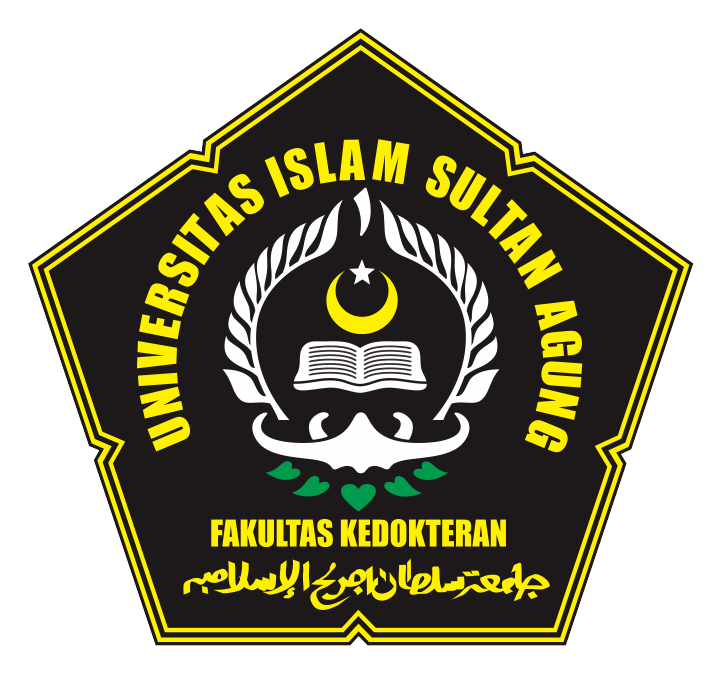Medical Faculty of Sultan Agung Islamic University - Indonesia
The Influence of Administering Propolis CMCE Extract on FSH, LH, and Testosterone Levels in MSG-Induced Male Wistar Rat
Objective : To prove the effect of CMCE propolis extract to increase FSH, LH and Testosterone levels in male Wistar rats induced by MSG.
Methods : This research was an experimental with post test only control group design used 18 male Wistar rats and divided into 3 groups. Each group on Control (K), P1 and P2 were induced by MSG of 140mg, then on P1 added 8,3mg CMCE propolis extract and P2 10,8mg for 21 days. Then on 22th day of blood was taken through the orbitalis sinus and serum was used for the analysis FSH, LH and Testosteron levels with ELISA method.
Results : ANOVA analysis test showed significant differences each group p=0,000(p˂0,05). Post hoc LSD test showed FSH, LH and Testosterone levels in the 8,3mg dose CMCE propolis extract and 10,8mg were significant different compared with control group p=0,000(p˂0,05). CMCE propolis extract 10,8mg dose had the significantly highest effect of FSH, LH and Testosterone levels than CMCE propolis extract 8,3 mg.
Conclusion : CMCE propolis extract 10,8mg/day for 21 days is proven to increase FSH, LH and testosterone levels in male Wistar rats induced by MSG.
Keywords: CMCE propolis extract; FSH levels; LH levels; Testosterone levels; Monosodium glutamate
- Agarwal, A. and Sekhon, L. H. (2010) ‘The role of antioxidant therapy in the treatment of male infertility’, 13(December), pp. 217–225. doi: 1 0.3109/14647273.2010.532279.
- Andriani (2017) ‘Pengaruh Pemberian MSG Terhadap Hormon Estradiol dan Kadar Hormon Progesteron pada Tikus Putih Betina (Rattus noregicus)’, Jurnal Iptek Serapan. Research of Applied Science and Education, 12.i(1), pp. 53– 63. doi: 10.22216/jit.2018.v12i1.338.
- Edward, Z. (2010) ‘Pengarruh Pemberian Asam Glutamate (MSG) Pada Tikus Jantan (Rattus norvegicus) Terhadap FSH dan LH’, Majalah Kedokteran Andalas, 34(2), pp. 160–166. doi: 10.22338/mka.v34.i2.p160-166.2010.
- Farooqui, T. and Farooqui, A. A. (2010) ‘Molecular Mechanism Underlying the Therapeutic Activities of Propolis : A Critical Review’, Current Nutrition & Food Science, 6, pp. 186– 199.
- Gocer, H. and Gulcin, I. (2011) ‘Caffeic acid phenethyl ester ( CAPE ): correlation of structure and antioxidant properties’, International Journal of Food Sciences and Nutrition ISSN:, 62, pp. 821– 825. doi: 10.3109/09637486.2011.585963.
- Guyton, A. C. and Hall, J. (2011) Reproductive and hormonal function of the male and function of the pineal gland. Textb. Med. Physocolgy. Phiadelphia: W.B. Saunders.
- Hoesada, I., Nasihun, T. and Isradji, I. (2016) ‘The Effect of Propolis Extract on MDA Levels (Malondialdehyde) and Sperm Quality on Epididimis (Experimental Study on Wistar Strain Male Rats Exposed to Kretek Cigarettes)’, Sains medika, 7(1), pp. 9–14.
- Iremonger, K. J. et al. (2010) ‘Glutamate regulation of GnRH neuron excitability’, Brain Research. Elsevier B.V., 1364, pp. 35–43. doi: 10.1016/ j.brainres.2010.08.071.
- Kefer, J. C., Agarwal, A. and Sabanegh, E. (2009) ‘Role of antioxidants in the treatment of male infertility’, International Journal of Urology, 16(5), pp. 449–457. doi: 10.1111/j.1442- 2042.2009.02280.x.
- Khaled, F. A., Yousef, M. I. and Kamel, K. I. (2016) ‘The protective role of propolis against thereproductive toxicity of mono-sodium glutaminein male rabbits’, International Journal of Chemical Studies, 4(2), pp. 04–09.
- Ko, E. Y., Sabanegh, E. S. and Agarwal, A. (2014) ‘Male infertility testing: Reactive oxygen species and antioxidant capacity’, Fertility and Sterility. Elsevier Inc., 102(6), pp. 1518–1527. doi: 10.1016/j.fertnstert.2014.10.020.
- Legowo, G. (2008) ‘Manfaat Madu sebagai Antioksidan dalam Melawan Radikal Bebas dari Asap Rokok untuk Menjaga Kualitas Sperma’, Medical Journal of Lampung University, 4(8), pp. 41– 42.
- Megawati, E. R. (2008) ‘Penurunan Jumlah Sperma Hewan Coba Akibat Pajanan Monosodium Glutamate’, Jurnal Biologi Sumatera, pp. 8– 14.
- Molina, P. E. (2009) Female reproductive system. In: Endocrine Physiology. New York: McGrawHill.
- Nasihun, T. (2009) ‘Pengaruh Pemberian Ekstrak Purwoceng (Pimpinella alpine Molk) terhadap Peningkatan Indikator Vitalitas Pria Studi Eksperimental pada Tikus Jantan Sprague Dawley’, Sains Medika, 1(1), pp. 53–62.
- Nasihun, T. (2012) ‘The effect of buceng extracts on androgen production in Sprague Dawley male rats’, Medical Journal of Indonesia, 21(1), pp. 28–31.
- Practice commitee of American Society for Reproductive Medicine (2013) ‘Definition of Infertility and recurrent pregnancy loss: a commitee opinion’, Fertility and Sterility. American Society for Reproductive Medicine, 99(1), p. 63. doi: 10.1016/j.fertnstert.2012.09.023.
- Rangkuli R (2012) ‘The Effect of Monosodium Glutamate (MSG) In Mice Red Blood Cell Micronucleus Formation’, Journal of Pharmaceutics and Pharmacology, 1(1), pp. 29–36.
- Ruca C.B. (2016) ‘Bhiochimica at Biophisica Glutamte exocicity and Ca2+-Regulation of Respiratory. Role of the Caa2+ activated mitokondrial transporter (CaMCs), BBA-Bioenergetic’, Elsiver. B.V, 1857(8), pp. 1158–1166.
- Susianingsih (2018) ‘Pengaruh Monosodium Glutamate terhadap Jumlah Sel Sertoli dan Sel Leydig pada Tikus Jantan’, Jurnal Biologi, 12, p. 31–2.
- Tremellen, K. (2008) ‘Oxidative stress and male infertility — a clinical perspective’, Human Reproduction Update, 14(3), pp. 243–258.
- Uke Y (2008) ‘Efek Toksik Monosodium glutamate (MSG) pada Binatang Percobaan’, Sutisning 3, 1(1), pp. 306–314.
- World Health Organization (WHO) (2010) ‘World Health Organization Laboratory Manual for the Examination and Processing of Human Cement’, in, pp. 13–114.
- Yousef, M. I. and Salama, A. F. (2009) ‘Propolis protection from reproductive toxicity caused by aluminium chloride in male rats’, Food and Chemical Toxicology. Elsevier Ltd, 47(6), pp. 1168–1175. doi: 10.1016/j.fct.2009.02.006
 Copyright (c) 2020 Sains Medika: Jurnal Kedokteran dan Kesehatan
Copyright (c) 2020 Sains Medika: Jurnal Kedokteran dan Kesehatan

This work is licensed under a Creative Commons Attribution 4.0 International License.
